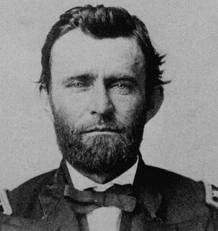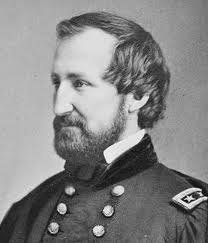 During the Confederate siege of Chattanooga, General Grant saw the forest and General Rosecrans only saw the trees. In the fall of 1863, after his retreat from Chickamauga, General Rosecrans was totally undone, physically, emotionally and mentally. The total Union losses numbered in excess of 16,000 men, killed, wounded or captured. The Federal Forces retired to Chattanooga and were nearly surrounded by the Rebel Army of General Braxton Bragg. According to Rosecrans, his Army was doomed to starvation or surrender. The Union Commander was psychologically incapable of determining any rational solution to his troopers dilemma.
During the Confederate siege of Chattanooga, General Grant saw the forest and General Rosecrans only saw the trees. In the fall of 1863, after his retreat from Chickamauga, General Rosecrans was totally undone, physically, emotionally and mentally. The total Union losses numbered in excess of 16,000 men, killed, wounded or captured. The Federal Forces retired to Chattanooga and were nearly surrounded by the Rebel Army of General Braxton Bragg. According to Rosecrans, his Army was doomed to starvation or surrender. The Union Commander was psychologically incapable of determining any rational solution to his troopers dilemma.
President Lincoln and General-In-Chief Halleck, old brains, telegraphed General Rosecrans,
 “Be of good cheer. We have unabated confidence in you and your soldiers and officers. In the main, you must be the judge as to what is to be done. If I was to suggest, I would say save your army by taking strong positions until Burnside joins you.”
“Be of good cheer. We have unabated confidence in you and your soldiers and officers. In the main, you must be the judge as to what is to be done. If I was to suggest, I would say save your army by taking strong positions until Burnside joins you.”
Lincoln knew that General Burnside was not the answer to Rosecrans’ plight, both being cut from the same clothe, as aggressive as a bag of hammers, the President remarked, that the besieged General seemed,
“confused and stunned like a duck hit on the head.”
Lincoln and Halleck immediately wired General Ulysses S. Grant to move his Army to Chattanooga, relieve the beleaguered Union Forces and drive General Bragg’s Army back into Georgia. Grant traveled, by horse, to the river city, spoke briefly with the afflicted Rosecrans, determining his total incapacity and summoned key staff, in order to inspect the personnel, assess the morale and determine the quality of the defensive perimeter.
General Grant observed the decrepit state of the encampment, the defeated and demoralized demeanor of the troopers. The soldiers had little, if any food, were subsisting on the hundreds of dying and rotting mules, that littered the camp and Grant knew that hungry or not, these Union soldiers suffered mainly from the humiliating defeat of Chickamauga.
Grant was aware that less than 60 mile away, in Bridgeport, Alabama, supplies awaited transport, but the General described the route that they must travel,
“There had been much rain and the roads were almost impassable from mud knee-deep
in places, and from washouts on the mountain-sides. I had been on crutches since
the time of my fall in New Orleans and had to be carried over places where it
was not safe to cross on horseback. The roads were strewn with the debris of
broken wagons and the carcasses of thousands of starved mules and horses.”
General Grant summoned the Chief of Engineers, General “Baldy” Smith, who had a bold plan to cross the Tennessee River, establish a beachhead at Brown’s Ferry and build a pontoon bridge, to span the river, cutting the distance to the supplies in Alabama by half. Smith’s innovative plan, the cracker line, was successful and food, clothing and medical supplies began flowing into Chattanooga. After 30 days of regular rations and medical attention, General Grant began delivering additional ordnance to the Union Forces, in preparation for a late November assault and eventual rout of General Bragg’s Confederate forces, that surrounded the strategic river city.
General Ulysses S. Grant saw the forest at Chattanooga, when General Rosecrans only saw the trees.
Bummer


Glad to hear you will be in east Tennessee soon. The Chickamauga Park Historian, Jim Ogden, is superb and can give you all kinds of great information. He sometimes does tours, too. I took one of his tours of Mocassin Bend National Archaelogical Park, a couple of years ago. This is part of the Cracker Line tour. We have earthworks still up on Stringer’s ridge at Mocassin Bend. I wrote a whole article with photos on my hike and the Cracker Line, a few years ago, here it is: http://www.dailykos.com/story/2011/02/28/950782/-Moccasin-Bend-National-Archaeological-Park-Saving-the-Cracker-Line-photo-diary
Sandy,
Bummer, wife and the Lab, Indiana, hit southwestern Missouri last summer, Tennessee kin fled before and after Civil War, from frying pan into the fire. Spent most of the time visiting cemetery sites and living relatives, picking up diaries and journals. Super hot and humid but, a dynamite adventure. The mountain folk of Sevier County and nearby kin will be the focus of the trip, lots of research to attend to. Some battle fields to explore and hopefully some oral history to absorb. Thanks for reading and enjoy the solitude.
Bummer
Also read your article on the KOS. Great writing. Don’t stop NOW!
Bummer
The cracker line! Never heard that one before. Thanks, Bummer.
Louis,
Cracker Line was also used during Grant’s siege of Vicksburg, when supplies were slow in arriving. It could have been Dana’s media phrase that played well in the newspapers of the time. “Baldy’s” engineers held the key to the Chattanooga break-out, they just needed someone like Grant to pull the trigger.
Bummer
It is hard to imagine things getting any worse for Chattanooga after the retreat from Chickamauga, but I guess it would have been possible if Lincoln followed through and brought down Burnside .
It would have been an opportune time for Bragg to do more than stay perched on the ridges around Chattanooga waiting for Rosencranz to surrender or starve, but that didn’t happen either. So we were somewhat lucky with both of those things not happening to the city of Chattanooga.
My great great grandfather served under General Thomas. The men loved him and there was no way he would surrender Chattanooga. Shoot, when they ran out of ammo at Chickamauga, he ordered men to “fix bayonetts”. It caused a lot of carnage, but it is probably better to die at Chickamauga then a slow, torturous death at Andersonville.
The toughest part after Chickamauga was waiting for the cracker line to open up. The troops expected reinforcement within days and instead of five weeks later. Over 10,000 horses and mules died during that time and the men were down to a couple of crackers and a sausage – if they were lucky. Thank God, General Grant brought in Sherman from the west and not the ‘starving” Gen. Burnside and his troops from the east.
Sandy,
Guess you can figure out that Rosecrans and Burnside are not favorites. Several other Union generals fit also. It’s hard to compare the others to Grant, Sherman, Sheridan and Thomas. Thomas took forever to move, but when he did, his logistics, supplies and troopers were more than prepared. Bummer and friends will be visiting Eastern Tennessee this coming Spring, exploring kin and battle fields of the area. Thanks for the informed comment!
Bummer